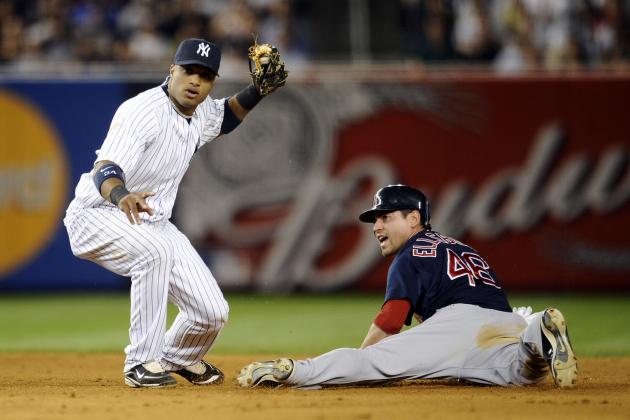 So players who steal a lot of bases often do not have such a high OPS+ mainly because of slugging percentages. Players who steal bases are historically known to be singles hitters. For example Juan Pierre is a career 84 OPS+ hitter, but has an average close to 50 steals a season. In 2012 Ben Revere stole 40 bases but had only an 89 OPS+.
So players who steal a lot of bases often do not have such a high OPS+ mainly because of slugging percentages. Players who steal bases are historically known to be singles hitters. For example Juan Pierre is a career 84 OPS+ hitter, but has an average close to 50 steals a season. In 2012 Ben Revere stole 40 bases but had only an 89 OPS+.Slugging percentage is calculated as total bases / total at bats. For total bases a single is worth one base, a double is worth two bases, a triple is worth three bases, and a home run is worth four bases. So if a stolen base practically turns a single into a double and a double into a triple then the stolen base should be accounted for in slugging percentage.
Before I elaborate, slugging percentage is often used to determine how well a player will drive in base runners. A player with a high slugging percentage will often hit doubles, triples, and home runs, hence driving in more runners. Additionally they will also get in scoring position better, because they do so from the get go. Slugging percentage has two practicalities.
So incorporating the stolen base into slugging percentage is very easy. Since a stolen base would be taking an additional base without an at bat, the number of at bats stay the same. The number of singles, doubles, triples, and home runs also stay the same. A stolen base would be worth one base and just added to the summation of bases.
 One player I want to look at in particular is Jacoby Ellsbury. The Yankees got a lot of heat for signing Ellsbury instead of Robinson Cano. Ellsbury had 124 singles, 31 doubles, 8 triples, 9 home runs, and 52 stolen bases in 2013. He also had 577 at bats giving him a traditional slugging percentage of .426. Because he was caught stealing 4 times and theoretically speaking took away a base, his net stolen bases is what will be used to calculated his slugging percentage with his stolen bases. So Ellsbury's slugging percentage including stolen bases would be .515 ass opposed to .426, 89 points higher.
One player I want to look at in particular is Jacoby Ellsbury. The Yankees got a lot of heat for signing Ellsbury instead of Robinson Cano. Ellsbury had 124 singles, 31 doubles, 8 triples, 9 home runs, and 52 stolen bases in 2013. He also had 577 at bats giving him a traditional slugging percentage of .426. Because he was caught stealing 4 times and theoretically speaking took away a base, his net stolen bases is what will be used to calculated his slugging percentage with his stolen bases. So Ellsbury's slugging percentage including stolen bases would be .515 ass opposed to .426, 89 points higher.Robinson Cano's slugging percentage in 2013 was .516 and if you include his 6 net steals, .525. Robinson Cano was and still is a much better baseball player than Jacoby Ellsbury. Cano had a .383 on base percentage as opposed to Ellsbury's .355 on base percentage. When accounting for stolen bases Cano's OPS was .908 in 2013 and Ellsbury's was .870. Ellsbury was just 38 points behind Cano, statistically speaking that is not very much.
To understand how important the stolen base is to Ellsbury in this particular case Prince Fielder had 32, 38, and 30 home runs and .471, .566, and .528 slugging percentages from 2010-2012 respectively. He did have an on base percentage over .400 each one of those years, but his average .521 slugging percentage is almost exactly Ellsbury's .505 career slugging percentage.Stolen bases are just as important as home runs.
To have some fun with this in 2012 Mike Trout stole 49 bases raising his slugging percentage from .564 to .642. Miguel Cabrera had a .606 slugging percentage with just 3 net steals. Mike Trout's on base percentage was .399 and Miguel Cabrera's was .393. Giving Mike Trout a 1.041 OPS and Miguel Cabrera a .999 OPS+. They are practically identical, but Trout was stellar on defense and used his speed in additional ways, but Miguel Cabrera won the triple crown in 2012 and won the MVP on the historical basis.
FUN WITH NUMBERS!

No comments:
Post a Comment